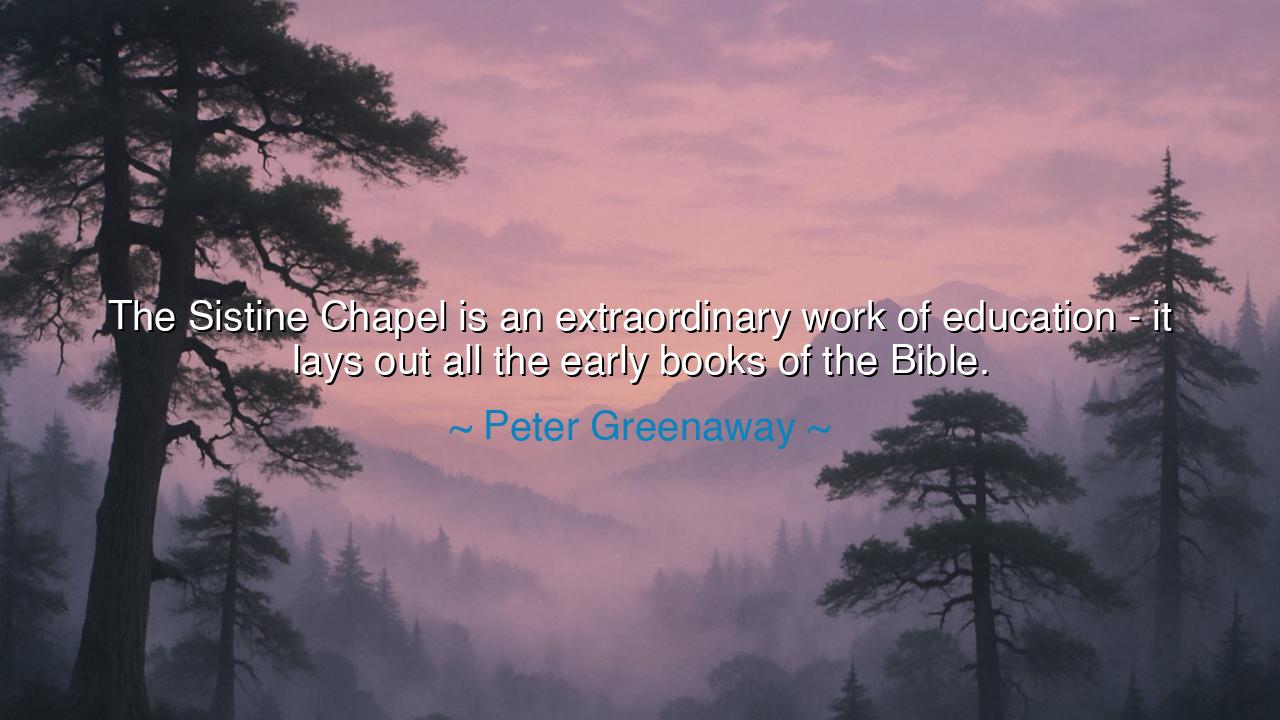
The Sistine Chapel is an extraordinary work of education - it
The Sistine Chapel is an extraordinary work of education - it lays out all the early books of the Bible.






The words of Peter Greenaway—“The Sistine Chapel is an extraordinary work of education – it lays out all the early books of the Bible.”—remind us that art is not merely ornament, but instruction; not merely beauty, but wisdom carved and painted for the soul of humanity. The Sistine Chapel, crowned by the genius of Michelangelo, is more than a gallery for the eyes—it is a cathedral for the mind, a scripture written not with ink but with color and form. Greenaway sees in it a school for the spirit, where those who could not read the sacred texts with their eyes might read them with their hearts through the power of image.
To call it a work of education is to acknowledge the deep role of art in shaping knowledge. In an age when books were rare and literacy scarce, the chapel itself became a library, its ceiling the pages of Genesis, its walls the prophets and sibyls, its altar the Last Judgment. Here, in a single space, the story of creation, of man’s fall, of covenant, and of redemption unfolds. The frescoes are not merely painted—they are lessons. Each gesture, each figure, each light and shadow is a teacher, drawing the soul into the mysteries of faith.
Michelangelo, with brush and chisel, became both artist and teacher, prophet and scribe. He transformed stone and plaster into an open Bible, so that all—princes and peasants alike—could see the drama of salvation. This was no small task, for he labored under the vault for years, his body strained, his spirit pressed, yet his vision unbroken. His ceiling is not simply decoration, but a vast classroom, where humanity learns its origin, its fall, and its hope. Greenaway, centuries later, merely uncovers what was always true: the Sistine Chapel is a book written for the eyes of mankind.
History offers us many such examples of art as education. The stained-glass windows of Gothic cathedrals told the lives of saints and martyrs in glowing color. The pyramids of Egypt were themselves silent textbooks, teaching about gods, kings, and eternity. The Bayeux Tapestry stretched across walls to recount battles and dynasties. Again and again, art has been humanity’s first textbook, its most enduring teacher, carrying knowledge through ages where few could read words but all could read images.
The lesson here is profound: education does not rest only in classrooms or in books, but in every form that conveys truth. The Sistine Chapel teaches us that the language of art is universal, transcending literacy, culture, and even time. The illiterate peasant of the 16th century could look upward and learn from Genesis as surely as the scholar with Latin scrolls in hand. Even now, centuries later, men and women from every corner of the earth look up at that ceiling and receive its teaching, its summons, its awe.
Greenaway’s words also challenge us to rethink education itself. Do we see it narrowly, as mere training, or broadly, as the shaping of the soul? The Sistine Chapel calls us to the broader view: that education is the awakening of imagination, the lifting of the heart toward wonder, the weaving together of memory, story, and truth. When we teach only facts, we build tools. When we teach through beauty, symbol, and vision, we build lives.
So, O listener, take this wisdom to heart. Seek your education not only in books, but in paintings, in music, in architecture, in the wonders that human hands and hearts have made. Look upon the Sistine Chapel, and see in it a school without walls, a scripture without letters, a teacher that whispers across centuries. Let your own work, however humble, also become a teaching for others—through beauty, through truth, through example. For as Michelangelo taught with his brush, so too may you teach with your life. And in this way, every act of creation may become a work of education for the generations to come.






AAdministratorAdministrator
Welcome, honored guests. Please leave a comment, we will respond soon